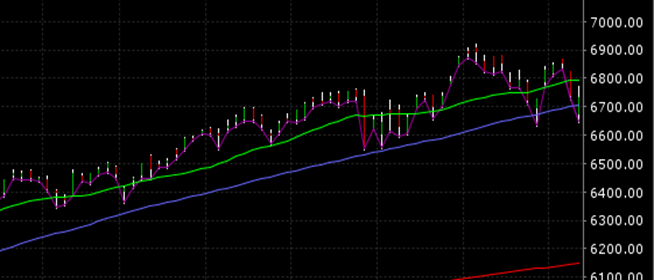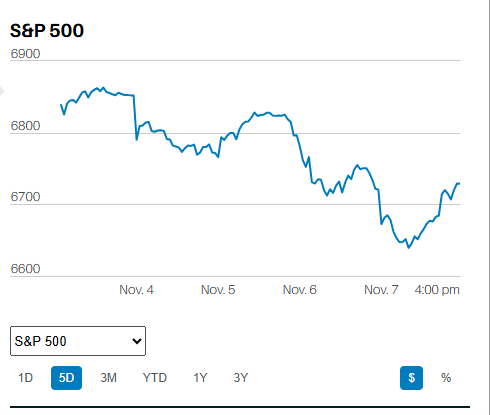I had a meeting with a client yesterday. He is a nice man, intelligent, earnest. My client is 65 years old and is looking for a way to supplement his income. I believe he would be back in the work force if he could find something suitable. He is concerned about his retirement, worried about the next bear market, worried he isn’t making enough now, before the next bear market. He and his wife recently went to hear an investment guru talk about a way to make 6% per year in commercial mortgage lending with the help of an investment company. They came away with the impression that there is little risk and that their investment time horizon could be as little as one year. I have offered to review the investment opportunity for them but I already know that it is probably pretty risky. The tip off? A one year investment that earns 6%.
Interest is the price of money, either what a borrower pays or a lender receives. Right now one-year Treasuries are yielding 0.10%, two-year Treasuries are yielding 0.58% and five-year Treasuries are yielding 1.79% (about the same as the official inflation rate). Treasuries are considered risk-free investments (if you don’t worry about inflation eating away the value of your money while the government has it). Notice that the longer the lending period the higher the price of money. Money has a time-value and an investment’s time horizon is integral to determining a fair market price for a lender’s money.
The time value of money is an acknowledgement that money can be made with money. If I make 5% in a year with my $100 in savings then in one year my money is worth $105. A second year of 5% results in $110.25 in my piggy bank. $100 today is worth $110.25 in two years… at 5%. Or looked at from the future point of view, $100 in two years is worth only $90.70 today because I only need $90.70 today to have $100 in two years… again at 5%. Using a 10% discount rate I need $82.65 today to have $100 two years from now. (One can begin to understand why public pension plans insist on maintaining 7% to 8% return assumptions in the face of 14 years of actual returns that have fallen considerably short. Taxpayers may not want to pony up additional money to ensure public pension plans can actually meet their commitments, so let’s just pretend 7% annually is doable going forward even though it’s extremely unlikely, at least over the next 10-years or so).
Investors postpone current consumption in order to consume in retirement. They want their money to earn as much as possible over the shortest time possible. Why settle for 5% per year if you can get 10%? Of course the answer is because the 10% investment might be too risky (highly variable with an outright loss possible). In fact, the S&P 500 has returned about 10% annually over the very long run, but investors in the S&P 500 lose money once out of every four years historically*. So an investment’s risk is part of an investor’s calculation when it comes to required returns. What is the likelihood that the investment will earn less than 10%? What is the likelihood of an outright loss?
Risk then is the other side of the investment coin. Every expected return must be adjusted for the risk that the investment will fail to provide the expected return. A 5% return that is 100% probable is superior to a 5% return that is only 50% probable with a 0% return also 50% probable . It is, in fact, possible to calculate average expected returns where return distributions are known. A 50% probability of 5% and 50% probability of 0% gives the investor an expected return of 2.5%, exactly half of the sure thing.
Investors compete for investments, searching diligently for the highest possible returns with the lowest amount of risk. The competition more or less guarantees that there won’t be many investments with risk-adjusted returns substantially above the rest at any given time. And that means that simply looking at what is out there for any given investment horizon can help an investor gauge the risk of an investment without knowing anything else but the expected return. For instance, if the marketplace is currently offering 0.10% for a single year in a risk free investment in the form of a U.S. Treasury then investors can’t reasonably expect to earn 6% in a one-year risk free investment. In fact, there isn’t a risk-free return available out to 30-years that even approaches 6% – the 30-year Treasury currently offers a mere 3.125%.
Moving out the risk continuum a bit nets investors 1.00% for a one-year CD from Ally Bank, 1.20% for a three-year CD and 2.00% for a 5-year CD. How safe is a one-year investment with Ally Bank (an internet bank)? Not as safe as Capital One 360, which is offering 0.40%, Wells Fargo offering 0.05%, Chase offering 0.02%, and HSBC offering 0.01% for the same one-year time horizon. How do I know? Because the market is demanding a substantially higher price to lend to Ally. And how do I know that? Investors can take-it-to-the-bank that Ally isn’t paying a penny more in interest on one-year CDs than necessary to attract capital, ergo the market is requiring Ally to pay a substantially higher rate, regardless of how Ally dresses it up in marketing spin. Yes, internet banks likely have a lower cost structure than bricks-and-mortar banks, but there is no business out there, none, that is going to pay more for an input cost (deposits in this case) than they absolutely have to pay.
Moving still further out the risk continuum to commercial mortgages takes us out of the one-year time horizon (commercial loans are typically for longer periods than just one year) but does take us to the asset subclass of interest to my client. Unfortunately, a quick check on line doesn’t show anyone willing to pay a commercial lender anywhere near 6% for the use of their money. Select Commercial Lending LLC (rated “A+” by the Better Business Bureau according to Commercial Lending’s web page) will lend on apartment buildings at 3.60% and office, retail, and industrial properties for as little as 4.25%. Steelhead Capital advertises multifamily small portfolio ($400,000 to $1mm) money available for 3.90% to 5.15% for 5-year periods. Steelhead can’t get 6% from a borrower without offering a 30-year loan (5.66% to 6.80% rates available).
Hold on! Eureka! Scrolling further down Steelhead’s website reveals one-year money available to borrowers for rehabilitation and bridge loans. Steelhead is only asking for between 7% and 14% on a one-year interest only loan. But why is Steelhead requiring such a high rate for the use of its one-year money? Or put another way why are borrowers willing to pay so much for a one-year loan? Let’s answer the question by first looking up a couple of definitions, starting with rehab loan.
Investopedia explains that a rehab loan has a “low down payment requirement compared to private-sector mortgages and puts rehab projects within reach for individuals who otherwise could not afford them. Supporters of this type of loan say it helps improve communities and broadens home ownership opportunities for individuals; critics say that it’s a risky loan product that isn’t offered without government underwriting for good reason.” Prospect Mortgage’s website includes a bullet on rehab loans pointing out that FHA 203(k) loans “Can be used to buy property otherwise not eligible for financing”.
As for bridge loans, Wikipedia helpfully points out that “Bridge loans are typically more expensive than conventional financing to compensate for the additional risk.”
So the answers to our two questions are: because they can and they can because (desperate?) borrowers have no lower-cost options.
Final Exam: Which of the following investments contains substantially more risk than the others?
A) one-year 0.10% B) one-year 1% C) five-year 5% D) one-year 6%
Yes, I’ll look at the commercial lending operation touted by the investment guru to retirees looking for additional yield (without taking too much risk), but the answer to the Final Exam question is D so I am pretty sure I know what I will find.
*If learning that the S&P 500 loses money every four years on average surprised you then perhaps you had better check your portfolio. We are closing in on our 6th straight year of positive gains.











